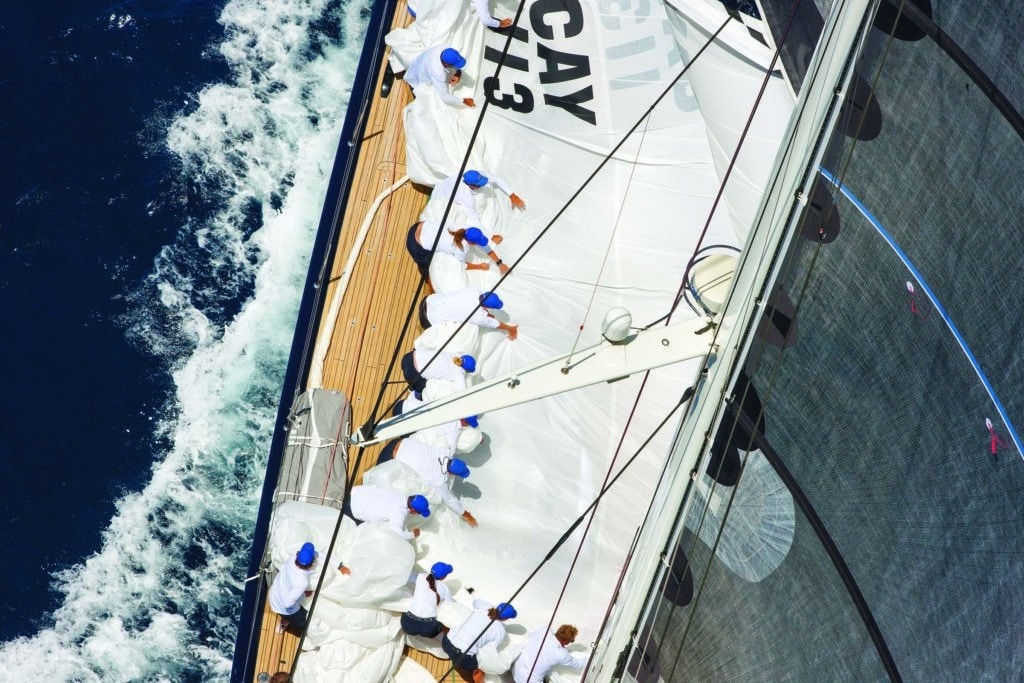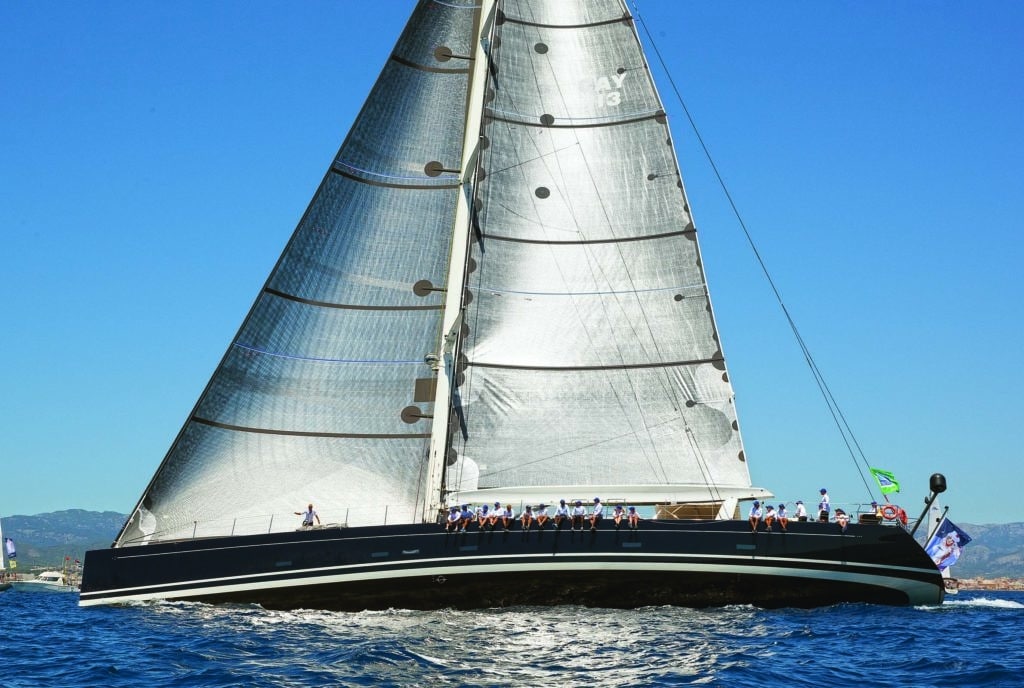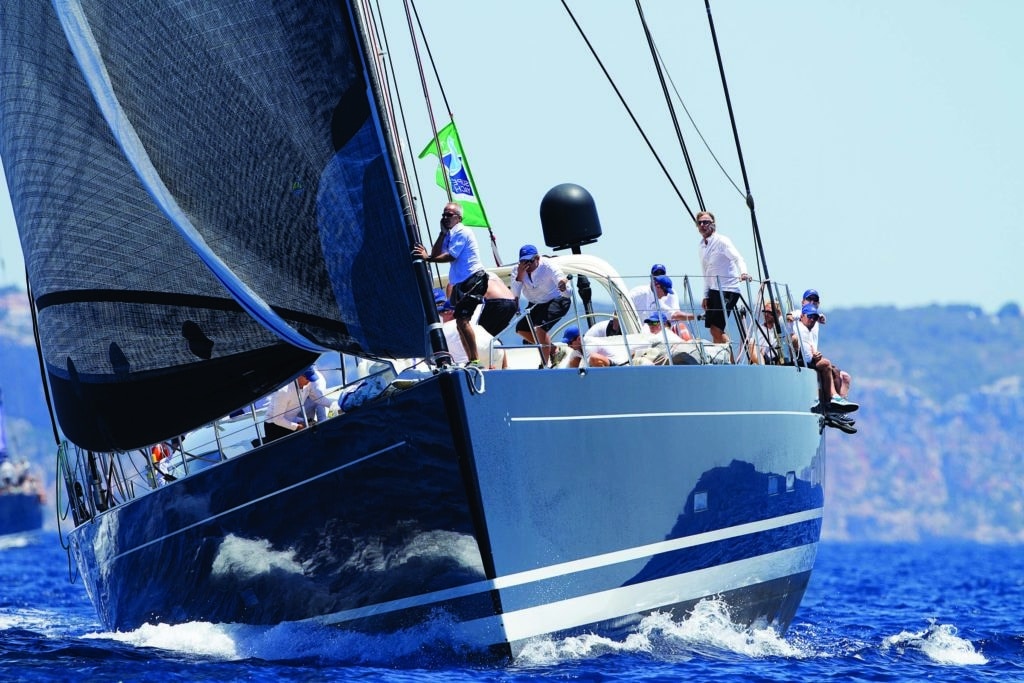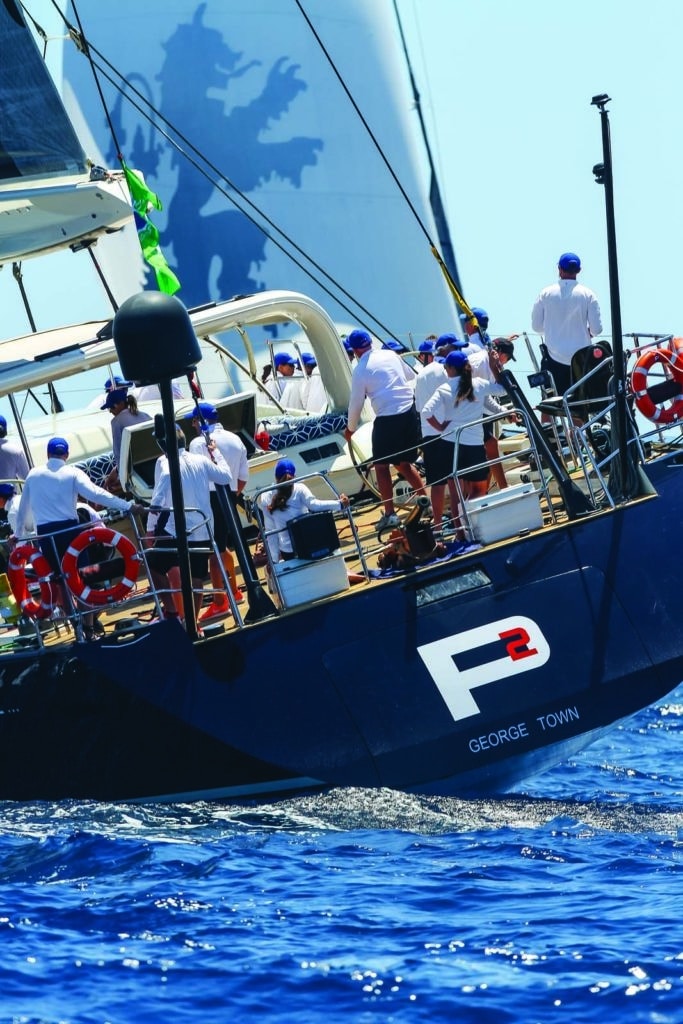
When you step aboard any superyacht, there’s an immediate impression: Everything is that much bigger. On P2, which is owned by Dr. W.E. “Ed” Bosarge, of Houston, there’s the gleaming white mast as tall as a giant redwood; the flared Park Avenue boom that’s so far off the deck, there’s no chance you’ll bump your head on it; winches the size of manhole covers; and teak decking as far as the eye can see. So robust and solid is P2, it doesn’t give the slightest hint of movement as its crew and guests board from the stern-hung gangway, itself a crafted bridge to luxury. Underfoot, the teak deck is warm and soft because, as a sign on the gangway reads, street shoes are not allowed. Sailing shoes, flip-flops or bare feet are requested; street grime is left at the docks. The deck is uncluttered and immaculate, with no coffee grinders to be found. Superyacht racing is push-button sailing.
I board P2 as it’s being readied for a practice day before the Superyacht Cup in Palma, Spain, the event for this rarefied tip of big-boat sailing. Crewmembers scurry between the boat and a pile of equipment on the seawall. It’s rush hour on the gangway, and nearby the afterguard is debating whether to use the “bucket” on the asymmetric spinnakers. The bucket is the snuffer, the almost-surefire piece of equipment that controls the 11,840-square-foot asymmetric gennaker during douses. Use it and, generally speaking, there won’t be any problems at the leeward mark.
There are counterarguments, however. The bucket can be a hassle, and a douse can go awry if a twist occurs. When the bucket is in use, douses must start a minute or so earlier than they would otherwise, to allow the crew to wrestle the giant sail into a sleeve that’s attached to the bucket. Using the bucket also means the spinnaker’s luff isn’t as straight or tight because the sleeve and bucket are stacked at the head of the sail. Eliminating the bucket allows the sail to fly better on the off-wind legs and to be carried longer into the leeward mark.
At this event, one final point from the camp opposing the bucket is impossible to refute: the weather forecast. Winds in the Bay of Palma, the racing area for the Superyacht Cup, are predicted between 10 and 14 knots for the three days of racing in late June. It then follows that at least 12 to 15 of the 28 working crew could wrestle the sail onto the deck quickly enough by hand. And so the decision is made: The bucket gets the heave-ho.
P2‘s A2 is roughly 30 percent larger than a baseball diamond, but the crew can handle it because the sailors are the crème de la crème of today’s pro-sailing circles. Some crewmembers are America’s Cup veterans, some have Volvo Ocean Race or maxiyacht experience, and others are simply lifelong sailors who’ve plied the grand-prix circuit for 20 to 30 years or longer.
“This is executive, platinum-level sailing,” says 51-year-old Wally Henry, a veteran of five America’s Cup syndicates who’s been racing grand-prix boats since 1983. “Mistakes on boats of this size can be catastrophic, so we look for high-experience guys who’ve done racing on bigger boats in high-pressure situations where you can’t make a mistake. That’s why you see a lot of talented sailors at these events. They’re old-school guys.”
Regardless of any particular yacht’s length overall, load waterline length or horsepower, each crew is a complex mix of personalities and strengths. To borrow from Aristotle, a crew’s whole is often greater than the sum of its parts. P2‘s army includes Americans, New Zealanders, Brits and an Antiguan, and with this group of experienced sailors, crew work becomes fluid as they push the limits of safety — without really grasping how close they are to the edge.
P2‘s crew knows how to handle a boat, which makes the elimination of the spinnaker bucket an easy decision in the end. Slick crew work is poetry in motion on board. During an orchestrated practice douse before the Superyacht Cup, the spinnaker halyard is released from its lock, and the sail billows in the wind, falling in the shadow of the headsail. While the bow turns up, the foredeck army gathers it under the foot of the headsail, bringing it directly onto the deck.

To the casual observer, it all happens effortlessly, even though the loads are substantial throughout the boat. The smallest-diameter lines are the jackstays, at 8 to 10 millimeters in diameter. Headsail sheets, at 22 to 25 millimeters, are about the diameter of a quarter. Guests are regularly reminded that heavy loads are in play; always keep one hand for yourself and one hand for the yacht.
“The evolution of superyacht racing is more toward performance,” says Tony Rey, P2‘s American tactician. “It used to be we’d go out and have a laugh, but when you get two boats in the same piece of water, you end up having a race. We sail these boats as hard as we can while doing it safely. One crash and everything’s done.”
Superyacht racing came in vogue about 25 years ago, when it was lovingly referred to as “bucket racing.” The Nantucket Bucket was the first regatta to pit large, unruly yachts, designed more for cruising comfort than racing, against each other. The yachts have always been in the 100- to 125-foot range. Today, however, the top end is pushed to 200-footers. Advances in materials and construction techniques mean larger vessels can be built at a fraction of the weight. Carbon, titanium, aircraft-grade aluminum, and modern aramids such as PBO and Dyneema all deliver serious weight savings.
The old line from the heyday of the 50-foot racing scene was once “no palm trees, no regatta,” and the equivalent for the superyacht crowd might as well be “no glitz, no glamour.” Venues such as St. Barths, Palma de Mallorca and Porto Cervo are idyllic destinations and favorites of the superyacht crowd. The oldest regatta is the St. Barths Bucket, which has been running for 22 years.
The Superyacht Cup is a close second, and on the occasion of its 20th anniversary, 22 boats are entered, ranging from the classic schooner Mariette of 1915 to the all-carbon 33-meter Win Win (which will go on to win overall honors under a custom scoring system, ORC Superyacht). The regatta village at the Muelle Viejo Marina is the scene of nightly crew parties, the highlight of which is called 20 Years of Rock, where crews are encouraged to release their inner Axl Rose or Ozzy Osbourne and show the rest of the fleet they rock the dance floor as much as they rule the racecourse. Another night sees a three-course owners’ dinner at the five-star St. Regis Mardavall Mallorca Resort.
Bosarge, my host for the Superyacht Cup, has been racing bucket regattas since the late 2000s, when he took delivery of the 180-footer Marie, and he’s won many events since then. “I do this for the camaraderie,” he says. “I love being in the outdoors.”
In his late 70s, Bosarge is emblematic of the influential and discreet owners in the superyacht crowd. Early in his professional career, he worked for IBM — specifically, on the flight-control systems for the NASA Saturn IB and Saturn V rockets — but his defining life work has been the application of quantitative analysis of financial markets to developing methods for yield enhancement of large fixed-income portfolios. In 2008, the Bosarge Family Foundation purchased the 72-acre Bahamian island Over Yonder Cay, in the Exumas, which Bosarge claims is the first “green” island in the world, operating on a hybrid renewable-energy system that employs three wind turbines and a 1.5-acre solar field.
Everything about him is larger than life, including his two yachts besides P2: Tenacious, a 114-foot sloop designed by Ted Hood and built by Trident, and Marie, a stunning black ketch from designer Andre Hoek, built by Vitters Shipyard in Holland. Marie is one of the few sailing yachts in the world that can actually dwarf a 135-foot J-class yacht.
Marie’s below-deck appointments, including the Steinway baby grand piano, are astounding. Bosarge says music has been a component throughout his life because his grandmother was a concert pianist and opera star. A pianist has been known to play at the beginning and end of Marie’s races. Artwork and antiques abound on board, adding colorful, eclectic touches. The galley puts most high-end home kitchens to shame. Equipped with freezers, ovens and stoves, it even has an ice cream maker. In superyacht racing, where everything is big, the little things do matter.

P2 Superyacht Cup Palma 2016. © Ingrid Abery Photography
Bosarge also has an affinity for historical armaments. He has one of the largest collections of cannons in the world, and Marie is fitted with port and starboard cannon nooks — honestly. There are two cannons on board, each with a 39-inch barrel and 2-inch bore, captured from the French frigate Médée in 1801 by two ships of the East India Co. They’re just behind the aft doghouse.
Bosarge loves the cannons so much that he’s been known to fire them off while on the racecourse. For two days of the 2016 Superyacht Cup, one is removed from Marie and positioned on the aft deck of P2. After taking the gun in the final race of the Superyacht Cup, Bosarge orders the race committee fired upon, and a loud bang and sweet smoke ring follow.
“I love it when Ed shows up,” says Henry. “He’s a fun human being, very personable. We all really enjoy it when he’s there.”
The cannons and baby grand make Marie a stunning yacht, but she’s a bear to handle. Visibility from the helm is low because of the doghouses and a 16,000-square-foot asymmetric gennaker, essentially the size of two baseball diamonds. “We were sailing in Antigua a few years ago and had the A2 up in 25 knots of wind,” says Henry, recalling the incident fondly. “It was too much wind, and Marie sort of wallows in the waves. A puff hit as the bow was starting up a wave, and we just went over and broached the piano. Marie was hard to sail. When we had the giant asymmetric up, you couldn’t see around it. P2 is a dream by comparison.”
Bosarge purchased P2 earlier in 2016, partly because Marie went through a significant refit that spruced up the six-year-old yacht to like-new status. Gone were the rope burns on the doghouses and chips from the railing. Marie was restored brilliantly, and it seemed inappropriate to treat it with the rigors of racing. With a three- to five-year lead time for a new superyacht these days, from conception to launching, Bosarge instead purchased the eight-year-old P2, designed by Philippe Briand and built by Perini Navi.
As a bonus, P2 came with a proven track record, as well as port and starboard thrones on the aft deck, from which Bosarge could view the racing and watch the performance data on personal displays. On the second day of racing, however, Bosarge is deeply preoccupied with his smartphone: He’s reading news of England’s Brexit vote. When you’re a high-frequency trader and your crew budget is on the order of $150,000 for a week of sailing, you need to pay attention to world markets.
Superyacht racing, in essence, is pursuit racing. The boats don’t start together. Instead, they’re typically sent off in two-minute intervals. To call the racing nail-biting would be a stretch; it’s not short-course, boat-on-boat stuff. The long-leg courses at the Superyacht Cup range from 16 to 28 nautical miles, and unless you’re the helmsman, tactician, one of three trimmers (mainsail, headsail and gennaker), bowman or main pitman, there isn’t much to do aboard except saunter from side to side during tacks, help move sails around, and gather the baseball diamond — er, gennaker — at the leeward mark.
“There are two roles within the crew,” says Henry. “The first is the technical guys, such as pit, bow, trimmers and afterguard — that’s 12 guys right there. The second are the moving guys; they move stuff all day. They’re experienced and strong, which they have to be in order to deal with 800-pound sails. Everyone shares in the responsibility of keeping the boat under control.”
Leading the operation is Wes Cooper, boat captain and race manager for P2 and Marie. Cooper has employed every member of the race crew and looks after logistics, flights, accommodations, and even chefs and restaurants for team dinners. He helmed Marie for six years and P2 since February, winning the St. Barts Bucket and the Superyacht Cup with Marie. P2 has won three of four regattas, making him, he says, the most successful helmsman on the superyacht circuit.

P2 Superyacht Cup Palma 2016. © Ingrid Abery Photography
With Cooper in charge, keeping the boat under control isn’t a problem in the 8- to 12-knot winds, and as we line up for the first start, excitement abounds. The first beat of any race is always exciting. It’s the time when you figure out who’s fast and who’s not. Would P2 be able to pass the three similarly sized yachts — Tenaz, Atalante and Sojana — that started ahead while also fending off the larger Salperton and Ganesha that followed? On a 5-mile beat in winds around 10 knots, it’s not a problem.
One thing a pursuit start allows is a port-tack start, which is how P2 takes to the racecourse. Rey calls for the port-tack start because he thinks there’s better breeze on the right side of the course, and he’s right. By the time we tack to starboard some 12 to 15 minutes later, we’ve easily crossed Sojana, while Tenaz is stuck in the left corner. A little later up the leg, Atalante crosses on port tack by a few lengths and rounds the windward mark first, followed by P2, Sojana and then Salperton, which had also started on port and followed P2 out to the right.
A long starboard-tack reach follows, and this is where the rules of superyacht racing differ from the Racing Rules of Sailing. Each yacht has a 40-meter bubble in which another yacht may not enter. So if a yacht is overtaking another, the one being overtaken must keep clear at all times. But it’s still odd to watch Atalante simply hold its line to leeward of P2, allowing us to sail right over the top without even a hint of an aggressive luff.
Once clear of the one class yacht ahead of us, P2 keeps extending around the racecourse to finish well ahead of the next boat, Sojana. P2 regularly beats its class rivals hands down, and at this event, it wins all three races by an average of less than two minutes. The closest race comes on the final day, when P2 ekes out a 47-second win over Ganesha. At 25 feet longer than P2, the Dubois/Vitters design was quick when the wind picked up to 16 knots on a long reach across the Bay of Palma. Ganesha‘s waterline length is about 20 feet longer than that of P2, and although P2 got the gun for crossing the line first, Ganesha nearly upended P2‘s perfect scoreline.
“There are four different wind strengths for which you get a rating: light, light to medium, medium to strong, and strong,” says Rey. “In the light winds, we were carrying a rating penalty of 0.7 seconds per mile, even if we weren’t using the water ballast. In the strong winds, it was five seconds per mile. By rating without the ballast, we were able to remove those penalties from our rating.
“I love taking boats that aren’t built for racing and making them faster,” he adds. “It’s an interesting game.”
It’s a game that the P2 brain trust, including Rey; the wildly popular Tom McLaughlin; project manager Nigel Ingram; trimmers Henry, Hartwell Jordan, and Peter Grimm of Doyle Sails; and helmsman Wes Cooper, who’s also the captain of Marie, all played brilliantly. The communication among the group was ever focused on boatspeed, windspeed and apparent-wind angle.
“I’m always looking at boatspeed in relation to apparent-wind angle,” says Grimm. “When the helmsman is struggling a bit, I’m talking to him about pressing into the jib to build speed and maybe ease the sheet a bit. My input from the low side is one component of overall input.
Hartwell might say, ‘Great mode,’ if he sees a puff coming, but I’m reporting what I’m seeing. Part of what I’m doing is a snapshot. It’s about telling the story as it goes.”
And that’s the story of P2, the superyacht with the eccentric owner and rock-star crew, doing what they do: living long and sailing hard.









